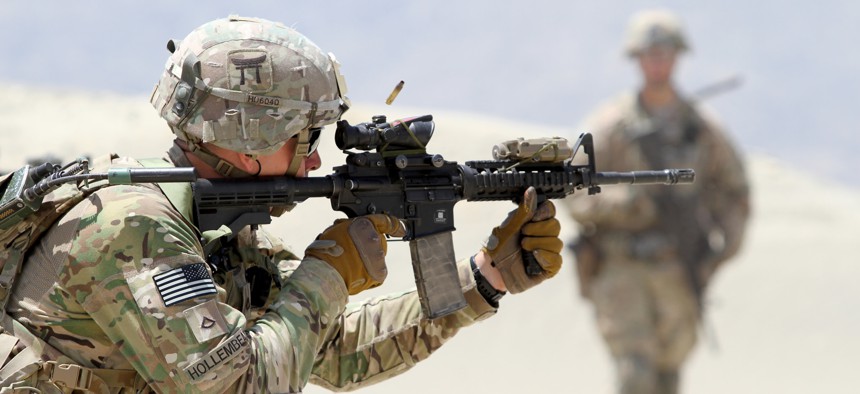
A U.S. Army Soldier, assigned to 3rd Brigade Combat Team, 101st Airborne Division, fires an M4 carbine rifle during partnered live fire range training at Tactical Base Gamberi, Afghanistan, May 29, 2015. U.S. Army photo by Capt. Charlie Emmons
Fate of Pentagon War Budget Left to Obama’s Successor
The Obama administration will submit its final budget to Congress in February, a spending plan that will include tens of billions of dollars for a 15-year-old war in Afghanistan and a new war against ISIS.
When President Obama departs the White House, he won’t only be leaving thousands of troops in Afghanistan, but also the special budget account that pays for most of the military’s operations overseas.
The spending account – known as the Overseas Contingency Operations, or OCO, budget – that many had hoped to get rid of or shrink substantially will be part of Obama’s final budget proposal, which he will most likely send to Congress in early February.
“They’ve [the White House Office of Management and Budget] been pushing us more than we’ve been pushing to try and find some way to wind out of OCO, but the [budget] caps have made that so hard,” Pentagon Comptroller Mike McCord said in a briefing with reporters Friday. “I think that we’re unfortunately going to have that problem with us and greeting the next administration,” McCord said.
That means the next president will have to decide how to pay for all of the military operations that have become the new normal over the past 15 years.
The budget caps McCord referenced began in 2013 and were the result of Congress’ inability to find a way to shrink the federal deficit. These spending limits were modified in late 2013 and most recently last month, giving the Pentagon more money, but still not as much as it says it needs to address a dangerous world with an increasing number of threats. The OCO war budget is not subject to the budget caps.
Since the OCO budget has long been seen as temporary, there was a concerted effort to move funding from it into the Pentagon’s annual base budget. Money for temporary offices and even arms projects that top Pentagon officials wanted to institutionalize was shifted as part of this effort. But as money got tighter (the result of the spending caps,) the Pentagon began shifting more money into the OCO budget. Instead of just paying for combat operations, money for military bases in the Middle East, stateside training and even repairing equipment when it came back to stateside have at times been funded through the OCO account.
The Pentagon requested $51 billion for the wars in 2016. The budget deal struck last month brings that up to about $59 billion. Since 2001, Congress has approved more than $1.5 trillion for the wars in Afghanistan and Iraq. That’s aside from the hundreds of billions of dollars the Pentagon gets each year to pay troops, train them, run facilities, buy new weapons and conduct research.
Obama’s Pentagon, for the most part, has asked for war money up front when it submits its entire federal budget. The Bush administration used to ask for the war money separate from the regular budgeting process through supplemental funding measures.
“I have certainly spent some time trying to think of a lot of new options, but there’s only a couple of variations on the theme of either we get the money upfront with a lot of restrictions … or you wait until after the fact,” McCord said. “I think this way has actually been an improvement over what preceded it.”
McCord says there’s more transparency in using the current method of requesting war money upfront. “Both from [a] taxpayer transparency side and our management side, I think this system stacks up pretty well compared to the old ways of supplementals,” he said.
The budget deal agreed to last month sets a war budget cap for 2017 at $59 billion, the same level as 2016.
